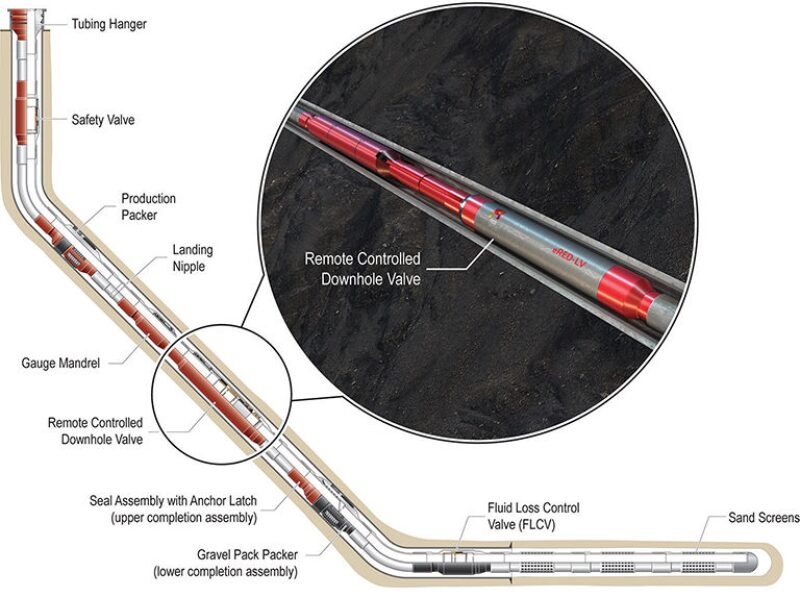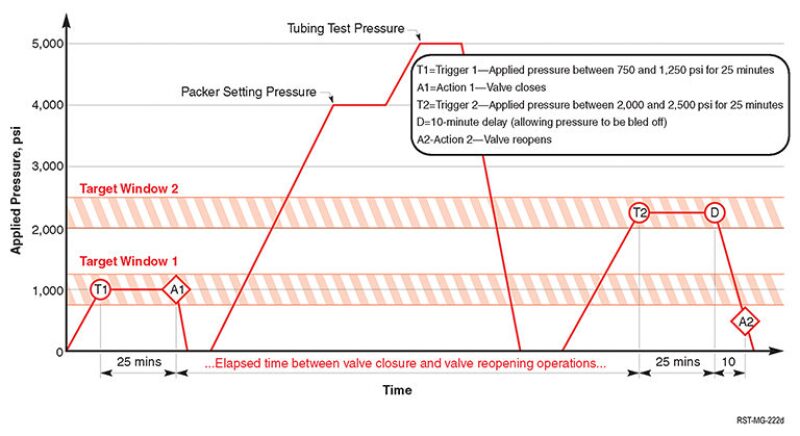In offshore deepwater and extended-reach wells, placing and removing deep-set barriers is often challenging largely because of the distances and depths involved. With operations more complicated in deviated and lateral wells, the challenges multiply. Often, coiled tubing or tractor systems are needed to set and retrieve deep-set barriers, increasing the expense, the time to complete the operation, and the inherent environmental and personnel risks.
Although placing the second, shallow-set barrier may be easier, it still involves elements of risk and significant expense because of the rig time needed. In some cases, up to 15 interventions are required during the completion phase of a well’s construction, thus resulting in considerable costs and increased safety risks.
However, if the barriers were deployed as an integral part of the completion string, and the well could be plugged or unplugged remotely, as often as required, no well intervention would be needed. The potential savings in rig time and the reduced risk would be significant, and having this capability could change the way that wells are completed.
A New Way to Complete Wells
A major step toward achieving this was taken in 2008 when Halliburton-Red Spider successfully deployed the eRED valve, a remotely operated ball valve that could be deployed on a lock or bridge plug to replace traditional plug and prong barriers.
The valve’s primary advantage was its remote operability that enabled it to be opened and closed as often as needed, each time eliminating an intervention. When the well completion is finished, the assembly is retrieved before the well is brought online. The valve has been used in about 200 jobs with more than 400 remote actuations successfully performed.
It soon became clear that a tubing-mounted, full-bore version of the valve would provide greater benefits because it would not require retrieval. Thus, the eRED-LV valve (Fig. 1) was developed, which enables operators to set or remove well barriers at any time without intervention or the use of surface control lines. With retrieval unnecessary, additional savings in rig time are achieved.

Valve Operation
The full-bore valve uses the developer’s Remote Open Close Technology, which enables the operator to activate the valve remotely without surface control lines. Communication is achieved by applying a predefined pressure at surface for a predefined time. Integrated electronics are programmed to recognize this unique pressure/time window as a command trigger to either open or close the valve.
Pressure applied outside the defined values is ignored by the valve. This means that pressure can be applied repeatedly to the tubing, for example, for integrity tests or packer setting, without the risk of inadvertently activating it.
The system is highly flexible; there is no fixed operational procedure for its operation. Each well operation is planned on paper and the valve is programmed subsequently to suit the application.
Should the valve fail, the ball is mechanically shifted to the open or closed position by use of a wireline-deployed shifting tool. The fully open position of the ball is confirmed by observing a pressure drop at surface and by drifting the shifting assembly through the valve.
Target Applications of the Valve
The technology can be used in any application in which wireline plugs are normally used. It is able to achieve the same results as wireline plugs without requiring repeated interventions or the use of surface control lines. It is also particularly suited to completion deployment for setting production packers and establishing barriers to secure the well while rigging down blowout preventers and installing Christmas trees.
Multiple tools can be deployed in a single well, with a unique signature established for each tool. This capability allows the operator to communicate with and operate each valve independently, thus considerably increasing the usefulness of the valve technology.
Testing and Commercialization
The development project of the full-bore valve began with testing at a component and subassembly level to prove that the technology would work and could be integrated into the main completion design. Potential failure modes were considered, tested, and documented to ensure a robust final design. Where applicable, industry standards were adopted; for example, the barrier module was qualified to the newly introduced ISO 28781:2010.
Once fully qualified, the technology was introduced to oilfield operations, with its first successful job completed in August 2012 offshore Equatorial Guinea. The technology has since been deployed successfully in the North Sea.
Case Study: Equatorial Guinea
Deployed as an integral part of the completion below the production packer, the full-bore valve was run into the hole in the open position to approximately 9,100 ft measured depth at a deviation greater than 80°.
With the tubing hanger landed, locked, and tested, the valve was commanded to close using a preprogrammed pressure/time trigger of 1,000 psi for 25 minutes. This pressure was applied against the closed flapper-type fluid loss device in the lower completion. The packer was set hydraulically against the closed valve and the tubing was pressure-tested. The subsurface safety valve was then closed, inflow tested, equalized, and reopened.
The programmed full-bore valve was reopened using a different pressure/time trigger of 2,250 psi for 25 minutes. To prevent a pressure surge on the lower completion, a programmed delay of 10 minutes allowed the tubing pressure to be bled down to 600 psi before the ball opening (Fig. 2). Opening of the valve was verified by a downhole pressure/temperature gauge reading.

The installation eliminated the need to deploy a conventional deep-set barrier and maintained the maximum production flow area. A rig-time saving of 1½ days was achieved with commensurate cost saving. In addition, all risks associated with the intervention in a highly deviated subsea well were eliminated.
Technology Evolution Continues
The remotely operated ball valve technology has evolved from the through-tubing version that is retrieved by wireline at the end of the completion process to the tubing-mounted, full-bore version that need not be retrieved. The technology has proved that it can eliminate interventions during completion deployment, thereby saving time and expense, and removing operational risk to the environment and personnel.
This year, the technology development has continued with the addition of a remotely activated, tubing-mounted circulation sleeve valve that will eliminate well interventions that require fluid displacement after the packer is set. The new circulation valve is slated to be deployed in Norway by year-end.

